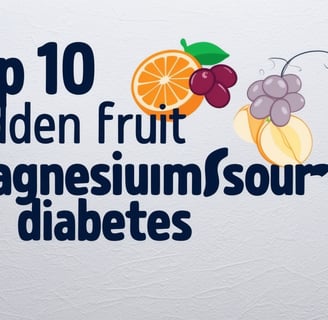Top 10 Hidden Fruit Magnesium Sources for Diabetes 🍇✨
Top 10 Hidden Fruit Magnesium Sources for Diabetes 🍇✨
Sophia Gold
8/11/20244 min read


Introduction: The Importance of Magnesium in Diabetes Management
Magnesium is a crucial mineral that plays a vital role in many bodily functions, including blood sugar regulation, nerve function, and muscle health. For individuals managing diabetes, maintaining adequate magnesium levels is essential, as magnesium helps improve insulin sensitivity, supports cardiovascular health, and reduces the risk of diabetes-related complications. While leafy greens and nuts are well-known sources of magnesium, certain fruits also offer a surprising amount of this essential mineral. In this article, I’ll reveal the top 10 hidden fruit sources of magnesium that can help support your diabetes management plan.
1. Bananas
What They Are:
Bananas are a popular fruit known for their potassium content, but they are also a good source of magnesium. A medium-sized banana contains about 32 mg of magnesium.
Benefits for Diabetes:
Bananas have a moderate glycemic index, meaning they release sugar into the bloodstream more slowly, helping to prevent blood sugar spikes. The combination of magnesium and potassium supports heart health, which is particularly important for individuals with diabetes.
How to Use:
Enjoy a banana as a snack or add it to smoothies.
Slice bananas over whole-grain cereal or yogurt for a magnesium-rich breakfast.
2. Avocados
What They Are:
Avocados are a unique fruit that is rich in healthy fats, fiber, and magnesium. One avocado provides about 58 mg of magnesium.
Benefits for Diabetes:
The healthy fats in avocados help stabilize blood sugar levels and improve insulin sensitivity. Their magnesium content supports overall metabolic health and helps reduce inflammation.
How to Use:
Add avocado slices to salads, sandwiches, or grain bowls.
Blend avocados into smoothies or use them to make a creamy avocado dressing.
3. Figs
What They Are:
Figs are a sweet and chewy fruit that provides a good amount of magnesium. One serving of dried figs (about 4 figs) contains approximately 22 mg of magnesium.
Benefits for Diabetes:
Figs are high in fiber, which helps slow the absorption of sugar and promotes stable blood sugar levels. Their magnesium content supports muscle and nerve function, which is important for overall well-being.
How to Use:
Enjoy dried figs as a snack or add them to oatmeal or salads.
Use fresh figs in desserts, smoothies, or as a topping for yogurt.
4. Blackberries
What They Are:
Blackberries are a nutrient-dense berry that provides about 29 mg of magnesium per cup. They are also high in fiber and antioxidants.
Benefits for Diabetes:
Blackberries have a low glycemic index and are packed with fiber, making them an excellent choice for blood sugar control. The magnesium content helps support cardiovascular health and reduces the risk of diabetes-related complications.
How to Use:
Add blackberries to smoothies, salads, or yogurt.
Enjoy fresh blackberries as a snack or in a fruit salad.
5. Raspberries
What They Are:
Raspberries are another berry that is rich in magnesium, providing about 27 mg per cup. They are also high in antioxidants and vitamin C.
Benefits for Diabetes:
Raspberries help regulate blood sugar levels by providing fiber and antioxidants that protect against oxidative stress. The magnesium content supports insulin function and overall metabolic health.
How to Use:
Mix raspberries into oatmeal, yogurt, or smoothies.
Use fresh or frozen raspberries in desserts, salads, or as a topping for pancakes.
6. Papayas
What They Are:
Papayas are a tropical fruit that is not only rich in vitamins A and C but also contains about 30 mg of magnesium per small papaya.
Benefits for Diabetes:
Papayas are low in calories and high in fiber, helping to regulate blood sugar levels. The magnesium in papayas supports heart health and reduces inflammation.
How to Use:
Add papaya slices to fruit salads or smoothies.
Enjoy fresh papaya as a snack or use it in salsas and desserts.
7. Kiwi
What It Is:
Kiwi is a small, nutrient-dense fruit that provides about 23 mg of magnesium per two kiwis. It is also rich in vitamin C, fiber, and antioxidants.
Benefits for Diabetes:
Kiwi has a low glycemic index and is high in fiber, making it an excellent fruit for blood sugar control. The magnesium content helps support muscle and nerve function and reduces the risk of complications.
How to Use:
Add kiwi slices to salads, yogurt, or oatmeal.
Enjoy kiwi as a snack or use it in smoothies and desserts.
8. Cantaloupe
What It Is:
Cantaloupe, also known as muskmelon, is a refreshing and hydrating fruit that contains about 19 mg of magnesium per cup of diced cantaloupe.
Benefits for Diabetes:
Cantaloupe is low in calories and high in water content, making it a hydrating and diabetes-friendly fruit. The magnesium in cantaloupe supports cardiovascular health and helps regulate blood sugar levels.
How to Use:
Add cantaloupe to fruit salads, smoothies, or yogurt.
Enjoy fresh cantaloupe as a snack or blend it into a refreshing juice.
9. Oranges
What They Are:
Oranges are a citrus fruit known for their vitamin C content, but they also provide about 13 mg of magnesium per medium-sized orange.
Benefits for Diabetes:
Oranges have a low glycemic index and are high in fiber, helping to regulate blood sugar levels. The magnesium content supports heart health and helps reduce inflammation.
How to Use:
Enjoy a fresh orange as a snack or add orange slices to salads.
Use orange juice in smoothies, dressings, or marinades for a burst of flavor.
10. Pineapple
What It Is:
Pineapple is a tropical fruit that is rich in vitamins, enzymes, and magnesium, providing about 20 mg of magnesium per cup of pineapple chunks.
Benefits for Diabetes:
Pineapple is high in fiber and contains bromelain, an enzyme that aids digestion and reduces inflammation. The magnesium in pineapple supports overall metabolic health and helps manage blood sugar levels.
How to Use:
Add pineapple to smoothies, fruit salads, or yogurt.
Enjoy fresh pineapple as a snack or use it in salsas and grilled dishes.
Conclusion: Boost Your Magnesium Intake with These Fruits for Better Diabetes Management
Magnesium is a vital mineral that plays a crucial role in managing diabetes, supporting insulin function, reducing inflammation, and promoting overall health. By incorporating these hidden fruit sources of magnesium into your diet, you can enhance your overall health and better manage your blood sugar levels. These fruits not only provide essential nutrients but also offer delicious and versatile options for a balanced and diabetes-friendly diet.
Resources for Further Reading:
Healthline: The Benefits of Magnesium for Health
National Institutes of Health (NIH): Magnesium and Diabetes Management


